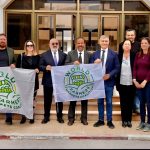This month, we celebrate the opening of the Nairobi Farmers Market in Kenya. One of the key objectives of the Mediterranean and African Markets Initiative (MAMi), the 25 January opening day not only marks an important and ongoing learning exchange between Italian farmers market practitioners (with Campagna Amica) and the new Regional Coalition of Farmers Markets (RECOF), but it also reveals how much pent up demand exists among consumers in sub-Saharan Africa for new markets that project intentionality, transparency, and a commitment to the dignity of farmers.
The market opening activities involved many key players in international development, including Italy’s Ministry of Foreign Affairs and International Cooperation, CIHEAM Bari and the support of the Italian Embassy in Kenya. In keeping with the MAMi Farmers Market Project’s goals, the new farmers market opening is not the end goal but a means to wider and deeper ambitions. Led by charismatic community market leader Dennis Andaye, his team and he have forged new partnerships with key stakeholders, like Kenya National Farmers Federation (KENAF). These new partnerships promise to set the stage for more markets, and more strategies that reflect the ultimate goal of purposefully leveraging farmers markets to restart a new trajectory for local food economies that enable farmers to diversity, consumers to develop a stronger voice in food choices and policies, and for food to begin to recognized as important local assets that chart great sovereignty among territories and cooperations among unlikely allies. After all, this is at the heart of Campagna Amica’s vision for multifunctional agriculture.
What makes this market so special is that it emerges together with other new markets of the MAMi Farmers Market Initiative: Alexandria’s new market that opened in October 2024, Tripoli’s set to open in April 2025, and new markets set for Tunisia later in the summer. Market leaders in these places represent a generation of new markets in a challenging region that share promising practices in real time (via the partnership between the WorldFMC Academy and CIHEAM-Bari). It is this recognition that helps to convert challenge into opportunity.
One of the fascinating conversations that took place in the middle of the opening day’s market was the question WorldFMC Director General Carmelo Troccoli asked the Kenyan market organizers: “If ugali is so important to Kenyan diets, then how’s that working for Kenyan farmers?” The team laughed, and reminded Carmelo that nearly all of the ugali is imported. The case of Ugali is hardly unique. A treasured national dish, ugali is a cornmeal (maize) similar to Italian polenta. It is also similar to many grain dishes all over the African continent (and world) favored by peasants and traditional farmers. However, what is remarkable about Ugali is that it is maize. Maize is not an indigenous crop to Kenya. In fact, while it may hold beloved status in Kenyan household kitchens, it was actually popularized in the 19th Century (and with reports of Portuguese colonists bringing it to Kenyan shores much earlier). Is ugali delicious? Yes, I have enjoyed it almost everywhere I’ve eaten it, especially served with sautéed greens (nightshade) and creamy dall. But, here’s the problem. Today, nearly all maize is imported to Kenya. Why is it an acceptable agricultural policy to import Kenya’s favorite ingredient? Couldn’t agricultural policies and development resources devote at least some effort towards cultivating homegrown ugali?
In the 1960s and 1970s, in the wake of decolonization, many newly independent nations pursued policy priorities that attempted to release dependent economies from the clutches of empire. These came to be known as import substitution. The concept is quite simple: If we can grow it or make it here, why don’t we? What does it take: Investment, training, and a desire for independence. This pathway towards independence, as we have since learned, is rocky and fraught with great challenges. When import substitution at a national level fell out of favour, in exchange for industrialization and modernization (to meet new neo-colonial export markets), these great lions seemed to slumber. Integration replaced independence. And yet today, the landless remain landless. Prices are set by the international distributors, bankers, and landgrabbers (all for the promise that someday nations will modernize).
So, what’s this have to do with farmers markets? The curious revival of these ancient networks for commerce and community has so much more to do with food sovereignty and the heroic efforts of leaders in communities of farmers and consumers who are asking the big questions about macro food policies, but know intuitively that the place to begin is at the micro level. What if import substitution were to reemerge but this time in a decentralized manner, at the territorial level? If there is virtually no Kenyan grown ugali, then why don’t we start here and now at the farmers market? Reintroduce the flavor of the terroir to the people who inhabit that terroir. After all, this is the taste of freedom. In the end, farmers markets = freedom.






